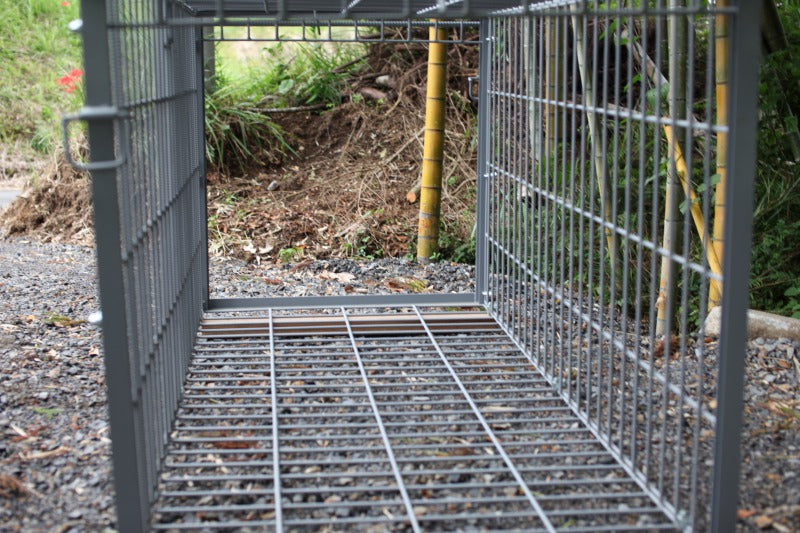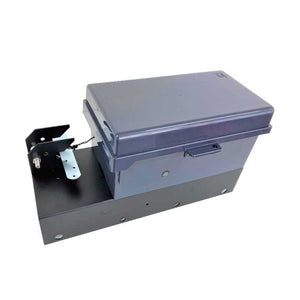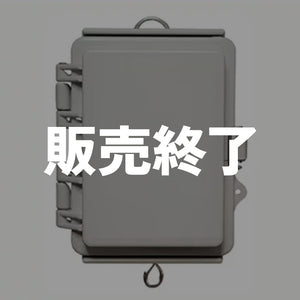In the midst of being annoyed by wildlife damage, there are times when you have to capture and exterminate them with traps. Especially in areas with high pest populations, it is imperative to increase trapping pressure by means of traps.
There are three main types of traps: "box traps," "kukuri traps," and "enclosure traps."
What is a box trap?
A box trap is a trap that traps prey by closing the entrance when the prey enters a box made of a cage or the like and the trigger is activated. A trap that has more than half of the ceiling surface open is treated as an enclosure trap, not a box trap.The advantage of box traps is that they are relatively easy to handle even for beginners. In the case of tying traps, skill and experience are required to set up traps and deal with caught prey, but compared to that, box traps are set up once they are assembled.
In addition, post-capture processing is less difficult than tying traps and large enclosure traps because the movement of the prey is limited. Therefore, it can be said that beginners are better suited to use safer box traps.
Even if you are not a beginner, box traps are often used because they are safer than kukuri traps to avoid accidents when setting traps in areas with a lot of human activity.
Structure and Mechanism of Box Trap
There are various types of box traps, all of which use bait to lure prey into the box. When prey enters the box, the trigger is activated and the entrance trapdoor closes.About box trap triggers
A trigger is a mechanism that initiates the movement of the trapdoor to fall. There are many different types, but they can be broadly categorized as follows:kick string method
A wire that acts as a trigger line is stretched inside, and when the prey touches it, the gate falls. This is the most common of the box trap trigger methods. Adjust the position and height according to the height of the prey.Footboard method
The moment the prey's weight rests on the footboard installed on the floor, the trigger is released and the door closes. The footboard method is often used for box traps that target small animals such as badgers, raccoons, and palm civets. Adjust the trigger according to the weight of the prey.Hanging bait system
A trigger line such as a metal rod or wire hangs from the top of the box trap and attaches bait to the tip. The door closes when the beast grabs the food or the trigger line, or grabs it with its front paws.Rotating rod (rotating shaft) method
When the prey enters the box trap and goes deeper, the stick rotates and the lid falls. The mechanism is simple, but in the case of individuals with strong vigilance, they tend to feel uncomfortable with sticks and tend not to enter the cage easily.
Even if they do get in, they will not reach the stick, and even if they eat food, they will go out without rotating the stick.
Electric method
It is effective for individuals who are wary and never touch visible wires. It also has the disadvantage of being fragile because the structure is more complex than other methods.
An infrared sensor detects the heat and size of the animal inside the box trap, and the built-in motor winds up the wire to open the door. Various mechanisms such as the method of operating the trigger have appeared.
About Box Trap Cages
The material of the cage and the size of the mesh differ depending on the target.wire mesh cage
It is mainly used for small targets such as palm civets, badgers, and raccoons. It has the advantage of being cheap, easy to assemble, and lightweight. On the other hand, it is less durable, so there is a risk of damage when capturing powerful prey.steel cage
Reinforced cages are suitable for medium to large animals such as strong boars and bears. It also has the advantage of being sturdy, safe and has a long service life. The disadvantage is that it is heavy and difficult to transport, and is more expensive than wire mesh.How to set up and set a box trap
If there is damage, you will want to capture it as soon as possible, but don't rush. In particular, timid and wary individuals will not approach easily even if a box trap is placed.
Also, in the case of animals with high fertility, the number of individuals increases quickly, so even if juveniles are blindly captured, it is difficult to reduce the damage. It's important to understand the key points to getting the right target right.
before setting the trap.
Acquire the necessary wildlife capture permits and licenses based on the Act on the Protection of Wildlife and Proper Hunting.
In addition, the box traps to be installed are marked with a sign that clearly states the address, name, permitter, permit date, permit number, purpose of capture, permit expiration date (hunter registration year and registration number in the case of hunting), It is necessary to demonstrate that you have a license to catch harmful animals and that you have a registered hunter. Also, traps must be set up by a person who has permission to catch them.
Installation location
First, check what was damaged and how, then look for places where many targets appear and where they often pass. Patrol areas with sightings and field signs to suggest possible locations if haunts aren't identified.
Other important checkpoints for choosing a location are permission from the land owner, access by car for large box traps, sufficient space for setting traps, and few people going in and out. .
If you take your dog around an area likely to be infested with prey, you may be able to tell if there is a target or not. It is also effective to set up a camera and check the movement of the target. Once you get a feel for the location, don't set up traps right away, just sprinkle bait on potential installation points and see how they bite.
For omnivorous targets, sow multiple prey species and find out which prey they prefer. Once you know where the best biting is, carefully check the footprints, excrement, food marks, and animal trails, and decide the position and direction to set the trap. It is a good idea to place the entrance facing the approaching direction.
In addition, if traps are set up in the immediate vicinity of farmland, etc., there is a risk that feeding will invite other individuals, and the damage will spread. It is better to install it in a place that is neither too close nor too far from the damaged farmland.
In addition, since feeding wild animals may increase damage, it is necessary to be conscious of catching the prey that is fed. If you are concerned that feeding them will cause more damage, use a different type of bait than the nearby crops.
Installation method
Consider the height of the target and select an appropriate size box trap. The height of the trap is not high enough, and if you hit your back, you may be wary and unable to enter the box trap.
Also, set the position and height of the trigger considering the size of the target. If there is a size difference between juveniles and adults, it is more efficient to target adults. In such cases, it is necessary to determine the position and height of the trigger by targeting adults.
For example, in the case of wild boars, it is almost always the cubs that enter the trap first. If the trigger is activated, only the juveniles will be caught, but the adult animals that cause damage will escape, and as a result, the adults will be wary of the trap and will not approach. The so-called threaded wild boar will increase, and the difficulty of subsequent capture will increase.
Also, even if the number of juveniles caught increases, there is a possibility that this will not directly lead to a decline in the number of individuals due to the high fertility of adults.
How to relax the target's vigilance is important when setting up a box trap. For example, cover the bottom of the trap with soil to make the wire mesh invisible.
Furthermore, if you want to increase the efficiency of capturing, you can use both box traps and tying traps (for example, you can use box traps to capture uribou, which are easy to catch with box traps, and set tying traps in the immediate vicinity of the box traps. Adult animals that do not enter are captured with a tie trap, etc.) is one way to round up.
feeding
Feeding is the most important part of the box trap trapping process. It is necessary to understand the ecology of the target well and to feed it appropriately. It is necessary to be conscious of gradually luring you into the back of the trap without rushing.When choosing a location, start catching using the bait you ate the most. In the case of a cautious individual, it is better to keep the door fixed and the trigger not activated until the prey is safe to eat in the box trap.
At first, bait is sprinkled on the outside of the box trap, and while watching how the bait is reduced, the bait is gradually collected and guided to the back of the trap. It takes a few days to get off guard. Feed as much food as you can eat in one day without fail. If the bait in the innermost part of the box trap is eaten completely, the trigger will be activated.
As an aside, people who are good at fishing tend to be more efficient at catching fish with traps. If you wait too long, the target's behavior may change, so you need to decide when to capture it.
If you leave it in the waiting state for a long time, an accident may occur. Depending on the target, a wide variety of different types of food can be considered as candidates, but it is necessary to make sure that wild birds and animals other than the target are not captured by mistake.
Here are some points to choose from:・Crops that are often damaged ・Easy to obtain ・Smells that are easy to attract ・Easy to handle (confectioneries, potatoes), etc.
Installation period
It is necessary to extend or shorten the installation period according to conditions such as the type of target, the damage situation, and the field sign.For example, nutria are often caught in a relatively short period of time (1 day to 1 week), but raccoons and palm civets are generally caught in 1 to 2 months. Wild boars and deer often do not eat the food in the trap immediately, so keep feeding them patiently for a week to 10 days. Since they are often caught at night, as a general rule, patrol every morning while box traps are in place.
If you find traces of eating food or trigger activation of something you could not catch, carefully observe the situation.
In addition, there is a possibility that non-target species with similar eating habits and habitats may be captured by mistake, and dogs and cats may be captured in suburban areas with many private houses. If anything other than the target is caught, release it immediately and increase the patrol frequency.
Post-capture treatment
Dispose of as soon as possible after capture. Rules for post-capture processing vary by region. For more information, please contact your local government representative. Let's consider a disposal method that is less burdensome for animals and humans.
Also, wild animals may carry ticks, parasites, other pathogenic bacteria and infectious diseases, so please pay attention to hygiene.

 箱罠
箱罠
 くくり罠
くくり罠
 パーツ類
パーツ類
 電気柵
電気柵
 自作キット
自作キット
 防獣グッズ
防獣グッズ
 監視カメラ
監視カメラ

![Fare Asahi Shiki Box Trap Big Size [Double Door]](http://inohoi.jp/cdn/shop/products/20180504_5c53af_300x300_crop_center.progressive.jpg?v=1597991101)
![Fare Asahi Shiki Box Trap Big Size [Single Door]](http://inohoi.jp/cdn/shop/products/20180506_c693cd_e969a0f5-abac-49ee-8f2b-6de0f385e3fd_300x300_crop_center.progressive.jpg?v=1597991123)
![Fare Asahishiki box trap medium size [single door] wire mesh specification](http://inohoi.jp/cdn/shop/files/main_300x300_crop_center.progressive.png.jpg?v=1720764665)
![Fare Asahi Shiki Box Trap Medium Size [Single Door] Deep Type](http://inohoi.jp/cdn/shop/files/f9d83dbb4ed93f76265b8cd23c07b474_300x300_crop_center.progressive.jpg?v=1726117508)
![Fare Asahi Shiki Boar and Deer Enclosure Trap Big Size [Single Door]](http://inohoi.jp/cdn/shop/products/20180609_0e5c80_300x300_crop_center.progressive.jpg?v=1597991633)
![Fare Asahi Shiki Monkey Box Trap [Single Door]](http://inohoi.jp/cdn/shop/products/2021-07-21T093626.944_300x300_crop_center.progressive.jpg?v=1628140528)
![Fare Asahi Shiki Enclosure Trap Big Size for Wild Boars and Deer [Double Doors]](http://inohoi.jp/cdn/shop/products/20180513_cc4969_300x300_crop_center.progressive.jpg?v=1597991336)
![Fare Asahi Shiki Small Animal Box Trap Small Size [Single Door]](http://inohoi.jp/cdn/shop/files/asahi-small02_071bc964-fa6b-4587-ae52-d15e905cc2c7_300x300_crop_center.progressive.png.jpg?v=1727766085)


 box trap
box trap
 tying trap
tying trap
 enclosure trap
enclosure trap
 Prevention and avoidance goods
Prevention and avoidance goods
 electric fence
electric fence
 trap surveillance camera
trap surveillance camera
 transportation goods
transportation goods
 Trap detection sensor
Trap detection sensor
 hunting supplies
hunting supplies
 hunting books
hunting books
 Anti-bird goods
Anti-bird goods
 Agricultural materials/machinery
Agricultural materials/machinery
 boar
boar
 deer
deer
 Kyon
Kyon
 monkey
monkey
 raccoon
raccoon
 Badger
Badger
 palm civet
palm civet
 raccoon dog
raccoon dog
 nutria
nutria
 mouse or rat
mouse or rat
 Mole
Mole
 bear
bear
 pigeon
pigeon
 Crow
Crow







